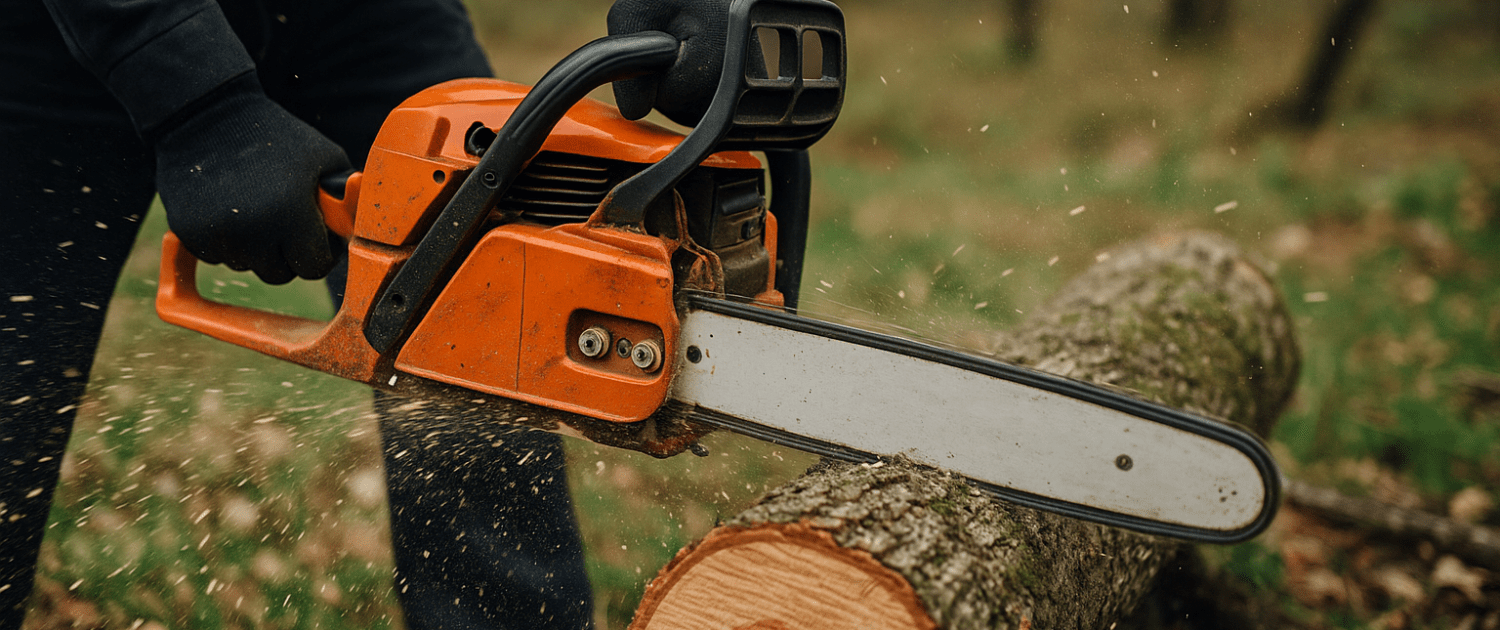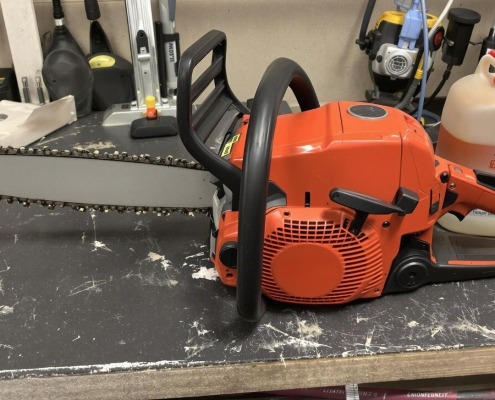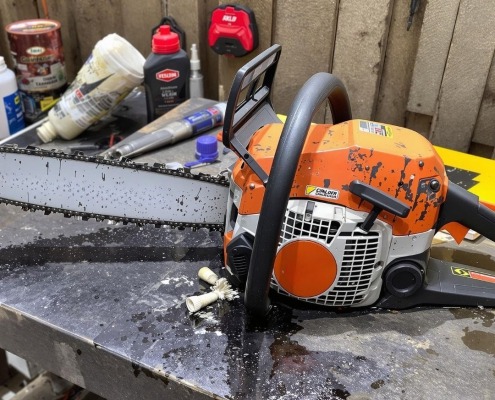A Beginner’s Guide to Chainsaw Chain Types
Steven E / Wednesday May 7, 2025
In the world of chainsaws, the importance of selecting the right chainsaw chain cannot be overstated. Chainsaw chains are not one-size-fits-all; instead, they come in a variety of types and configurations, each designed for specific cutting tasks and conditions. The choice of chainsaw chain can make a significant difference in cutting.
Whether you’re a professional lumberjack, a dedicated DIY enthusiast, or someone in between, this article is your guide to making informed decisions for cutting.
If you need any replacement parts for your appliance, you can enter your model number at AppliancePartsPros.com to order them. Most orders arrive in just two business days, and we have thousands of free guides to show you how to install your new parts.
The information in this article may not apply to your specific appliance model. We recommend consulting your manufacturer’s documentation or contact us with any questions.
Chainsaw chain parts
- Drive links: These are the links that engage with the chainsaw’s drive sprocket, transferring power from the engine to the chain. The number of drive links affects the chain’s length and compatibility with your chainsaw. The number and arrangement of drive links determine whether a chain is compatible with your chainsaw. Matching the drive link count to your chainsaw’s specifications is important.
- Cutters: The cutters are the tooth-like protrusions on the chain responsible for cutting through wood. They come in various shapes and designs, depending on the chain type, and their sharpness is necessary for effective cutting. Different cutter types are suited for specific cutting tasks, ranging from precision cutting to aggressive cutting in tough wood.
- Depth gauges: Also known as rakers, these components determine the depth to which the cutters penetrate the wood. Properly adjusted depth gauges control the size of wood chips produced. Incorrect depth gauge settings can lead to poor cutting and potential kickback.
- Tie straps: Tie straps provide stability and control to the chain during cutting, contributing to smoother operation and reduced vibration.
- Gullet: The gullet is the curved section between two cutters, and it serves as a space for wood chips to accumulate before being expelled during the cutting process.
Read more: How to Change the Pull Cord on a Chainsaw
Types of chains
Full-chisel chains
- Sharp, square-cornered cutters for aggressive cutting.
- Ideal for hardwoods and clean-cutting tasks.
- High cutting speed and efficiency.
Ideal for:
- Professional logging and timber harvesting.
- Felling large trees.
- Precision cutting for firewood.
Limitations:
- Prone to dulling quickly in dirty or abrasive conditions.
- Increased risk of kickback due to aggressive teeth.
Semi-chisel chains
- Rounded-cornered cutters for durability.
- Suitable for a variety of wood types and conditions.
- Maintains cutting sharpness longer than full-chisel chains.
Ideal for:
- General-purpose cutting, including softwoods and hardwoods.
- Pruning and limbing tasks.
- Cutting dirty or frozen wood.
Limitations:
- Slightly lower cutting speed compared to full-chisel chains.
Low-profile chains
- Reduced kickback risk due to low-profile cutters.
- Ideal for occasional and novice users.
- Good balance between cutting speed and safety.
Ideal for:
- Light-duty tasks such as trimming and small branch cutting.
- Homeowner and occasional use.
Limitations:
- Slightly reduced cutting efficiency compared to other chains.
Safety chains
- Features additional safety features to reduce kickback.
- Rounded-cornered cutters and anti-kickback links.
- Designed for maximum user protection.
Ideal for:
- Novice users and those concerned about kickback.
- Homeowners and hobbyists.
- Light to medium cutting tasks.
Limitations:
- Reduced cutting speed and efficiency compared to other chains.
Carbide-tipped chains
- Extremely durable and long-lasting cutters.
- Ideal for cutting abrasive materials like concrete or ice.
- Maintains sharpness even in challenging conditions.
Ideal for:
- Cutting in extreme conditions, such as rescue operations.
- Cutting concrete, stone, or ice.
- Professional use in harsh environments.
Limitations:
- Higher initial cost compared to other chains.
- May require specialized tools for sharpening.
Read more: How To Replace A Chainsaw Chain: Easy Steps!
Choosing the right chain
- For softwoods like pine or cedar, semi-chisel or low-profile chains are suitable due to their versatility and ability to maintain sharpness.
- Full-chisel chains excel in hardwoods like oak or hickory, providing faster and cleaner cuts.
- Semi-chisel chains are a balanced choice for mixed wood types.
- Full-chisel chains are ideal for clean, dry wood as they offer high cutting speed and efficiency.
- Semi-chisel chains are better suited for cutting wood with dirt, frozen moisture, or other contaminants, as they maintain sharpness longer.
- Beginners and occasional users benefit from low-profile or safety chains, which reduce the risk of kickback and are easier to control.
- Users with experience and confidence can opt for full-chisel or semi-chisel chains, depending on the cutting task and wood type.
- Ensure the chain’s drive link count matches your chainsaw’s bar length specifications. Consult your chainsaw’s manual for compatibility.
- Match the chain’s pitch (distance between drive links) and gauge (width of the drive links) to your chainsaw’s bar specifications.
- Full-chisel chains tend to dull faster but offer higher cutting speeds. If you’re willing to sharpen the chain more frequently, they are a suitable choice.
- Semi-chisel chains retain sharpness longer and require less frequent sharpening.
- For tasks like firewood preparation or precision cutting, full-chisel chains provide clean and efficient cuts.
- Semi-chisel chains offer a balanced approach and are suitable for a wide range of cutting tasks.
Maintaining and sharpening chains
- After each use, thoroughly clean the chain and bar to remove dirt, sawdust, and resin buildup.
- Keep the chain properly lubricated with chainsaw bar oil to reduce friction and heat during cutting.
- Maintain proper chain tension by checking the slackness of the chain regularly. Follow your chainsaw’s manual for tensioning instructions.
- An overly tight chain can lead to premature wear, while a loose chain can pose safety risks and damage the bar.
- Wear appropriate safety gear, gloves, and goggles to protect yourself from sharp debris.
- Ensure that all cutters are equally sharp to maintain balanced cutting performance.
- Occasionally lubricate the file guide to reduce friction and extend its lifespan.
- Sharpen the chainsaw chain when you notice a decrease in cutting efficiency or when the chain becomes difficult to control.
- The frequency of sharpening depends on factors like wood type, cutting conditions, and chain type. A general guideline is to sharpen every few hours of cutting.
- Avoid over-sharpening the chain, as excessive filing can lead to rapid chain wear.
Tips for extending lifespan
- To even out wear, periodically remove the chain from the bar, rotate it 180 degrees, and reattach it. This helps utilize all parts of the chain equally.
- In addition to rotation, flip the chain over so that the cutters on the bottom become the new top cutters. This extends the life of the chain and ensures uniform wear.
- Purchase a chainsaw chain file guide or file holder for your chain’s specific pitch. This tool helps maintain consistent filing angles and tooth lengths, resulting in more effective sharpening.
- Sharpen the chain regularly to prevent excessive wear. A dull chain places more stress on the engine.
- After use, clean the chain thoroughly to remove dirt, debris, and sawdust. Apply a light coating of oil to prevent corrosion.
- Store the chain in a dry, cool location to prevent rust and deterioration.
- Consider using protective chain cases or covers to shield the chain from dust, moisture, and damage during storage.
- Maintain proper chain lubrication to reduce friction and heat during cutting. Insufficient lubrication can lead to overheating and accelerated wear.
- Keep the chainsaw bar clean and free from dirt and debris. A clean bar reduces friction and prolongs the life of the chain.
- Periodically inspect the bar for wear, burrs, or damage. Replace or repair the bar as needed to support the chain.
- Be cautious when cutting near the ground or where hidden objects like nails or rocks may be. Hitting hard objects can quickly dull the chain and damage the bar.
- When the chain reaches a point where sharpening and maintenance are no longer effective, replace it promptly to avoid unnecessary strain on the engine.
Read more: How To Clean A Chainsaw
Additional information
Thanks for reading! If you need replacement parts for any of your appliances, check out AppliancePartsPros.com, where you can enter your model number to find exactly what you’re looking for. Most orders arrive in two business days, and we have thousands of free resources to show you how to install your new parts.
You can also reach our award-winning customer service team at 1-877-477-7278, chat with a pro on our website and watch thousands of free video tutorials on our YouTube channel.
With nearly a decade of experience in providing top-notch customer service regarding appliance parts and repair, Steven enjoys sharing practical advice, troubleshooting tips, and interesting information to help readers stay informed.





